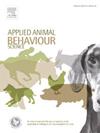Biopolymer-based nesting material for sows and its consequence on nest-building behavior, farrowing kinetics and piglet vitality
IF 2.2
2区 农林科学
Q1 AGRICULTURE, DAIRY & ANIMAL SCIENCE
引用次数: 0
Abstract
In the present study, we evaluated the effects of a soluble and biodegradable biopolymer-based material, structurally resembling natural fiber, as an alternative nesting-material for prepartum gilts. A total of 18 first parity sows and their litters were studied. One hour after induction of farrowing, sows were assigned at random into two experimental groups: sows without nesting material (CON, n = 9), serving as controls, and sows provided with 3.0 kg of a biopolymer-based nesting-material 24 h before the expected date of farrowing (BN, n = 9). In the prepartum period (18 h before farrowing), a lower (p = 0.016) percentage of postural changes were observed for BN sows. Moreover, BN sows performed more nesting-building behavior (p < 0.001) and had reduced redirected nest-building behaviors (p < 0.001). Sows in the CON group spent more time performing redirected nest-building behavior during farrowing than BN sows (12.5 % vs 3.9 %, p = 0.005). Sows in the BN group had shorter farrowing duration compared to CON sows (277 min vs 198 min, p = 0.025). The number of total piglets born, piglets born alive, and stillborn did not differ among groups (p > 0.05). Piglets in the BN group had higher blood pH (7.36 vs 7.34, p = 0.029), higher blood glucose (36.11 vs 29.45, p = 0.046) and lower blood lactate concentrations (3.33 vs 3.88, p = 0.035). Piglet mortality in the first 24 h and during the remaining lactation period were not different (p > 0.05) among experimental groups. In conclusion, our study demonstrated that providing a biopolymer-based nesting-material for prepartum sows, structurally resembling natural fibers, was effective in facilitating the expression of nest-building behavior, resulting in improved farrowing performance and piglets blood gas parameters.
基于生物聚合物的母猪筑巢材料及其对造窝行为、产仔动力学和仔猪活力的影响
在本研究中,我们评估了一种可溶性和可生物降解的生物聚合物基材料的效果,这种材料的结构类似于天然纤维,作为预备后备母猪的替代筑巢材料。对18头初胎母猪及其窝仔进行了研究。诱导分娩1小时后,将母猪随机分为两组,一组为未添加筑窝材料的母猪(CON, n = 9)作为对照组,另一组为预产期前24 h添加3.0 kg生物聚合物筑窝材料的母猪(BN, n = 9)。在准备期(分娩前18 h), BN母猪体位变化的百分比较低(p = 0.016)。此外,BN母猪表现出更多的筑巢行为(p <; 0.001),并减少了重定向筑巢行为(p <; 0.001)。CON组母猪在分娩期间比BN组母猪花费更多的时间进行重定向筑巢行为(12.5 % vs 3.9 %,p = 0.005)。BN组母猪产仔持续时间较CON组短(277 min vs 198 min, p = 0.025)。仔猪总产仔数、活产仔数和死产仔数各组间无显著差异(p >; 0.05)。BN组仔猪血pH值较高(7.36 vs 7.34, p = 0.029),血糖值较高(36.11 vs 29.45, p = 0.046),血乳酸浓度较低(3.33 vs 3.88, p = 0.035)。仔猪在前24 h和剩余哺乳期的死亡率在各试验组间无显著差异(p >; 0.05)。综上所述,我们的研究表明,为预备母猪提供一种结构类似于天然纤维的生物聚合物筑巢材料,可以有效地促进筑巢行为的表达,从而提高分娩性能和仔猪血气参数。
本文章由计算机程序翻译,如有差异,请以英文原文为准。
求助全文
约1分钟内获得全文
求助全文
来源期刊

Applied Animal Behaviour Science
农林科学-行为科学
CiteScore
4.40
自引率
21.70%
发文量
191
审稿时长
18.1 weeks
期刊介绍:
This journal publishes relevant information on the behaviour of domesticated and utilized animals.
Topics covered include:
-Behaviour of farm, zoo and laboratory animals in relation to animal management and welfare
-Behaviour of companion animals in relation to behavioural problems, for example, in relation to the training of dogs for different purposes, in relation to behavioural problems
-Studies of the behaviour of wild animals when these studies are relevant from an applied perspective, for example in relation to wildlife management, pest management or nature conservation
-Methodological studies within relevant fields
The principal subjects are farm, companion and laboratory animals, including, of course, poultry. The journal also deals with the following animal subjects:
-Those involved in any farming system, e.g. deer, rabbits and fur-bearing animals
-Those in ANY form of confinement, e.g. zoos, safari parks and other forms of display
-Feral animals, and any animal species which impinge on farming operations, e.g. as causes of loss or damage
-Species used for hunting, recreation etc. may also be considered as acceptable subjects in some instances
-Laboratory animals, if the material relates to their behavioural requirements
 求助内容:
求助内容: 应助结果提醒方式:
应助结果提醒方式:


